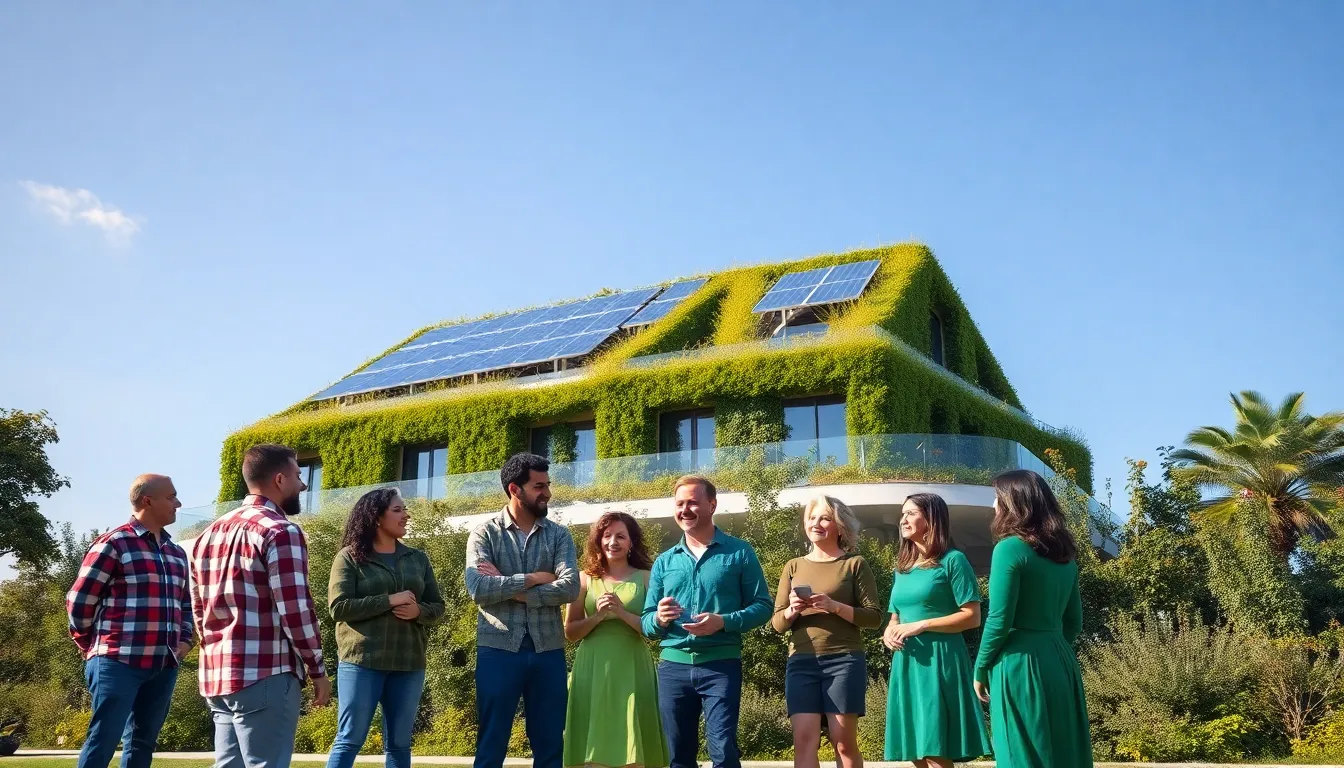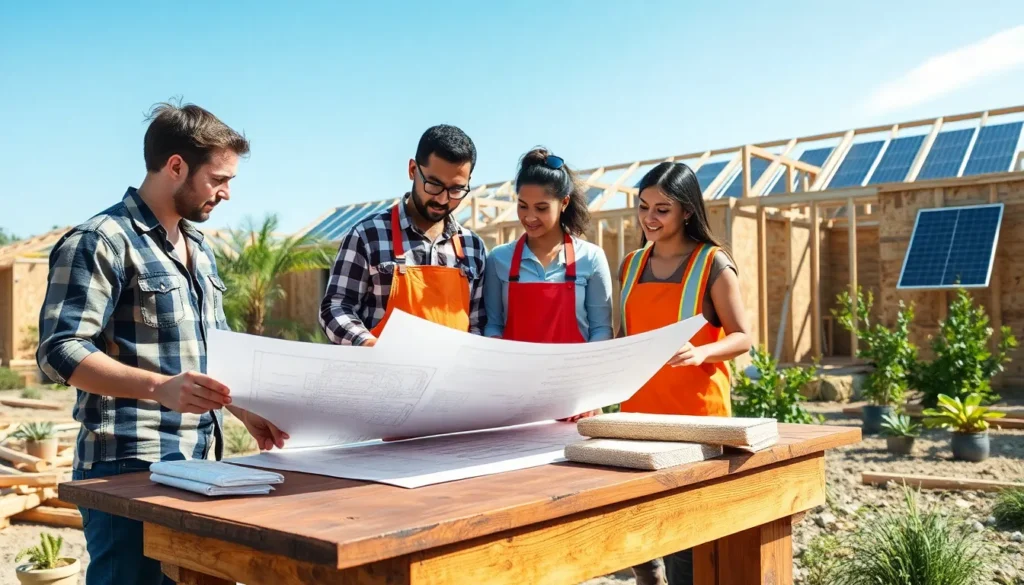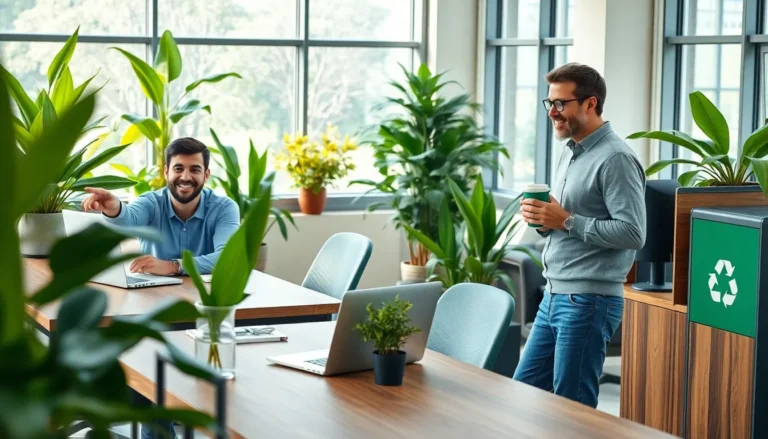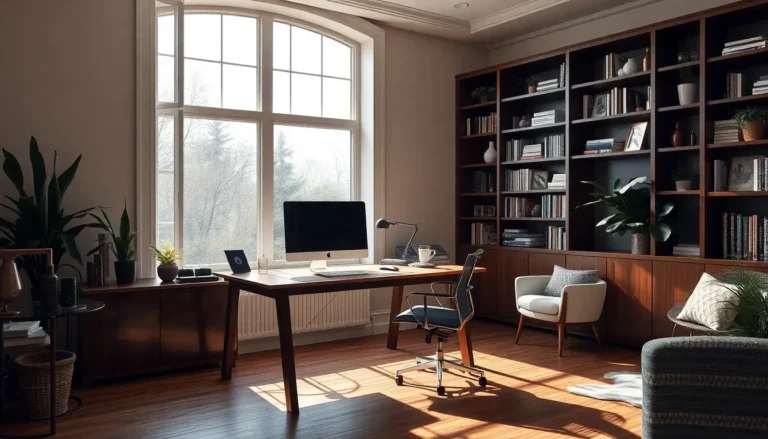Table of Contents
ToggleIn a world where the planet’s health hangs in the balance, green building construction emerges as the superhero we didn’t know we needed. Gone are the days of sacrificing style for sustainability. Now, eco-friendly designs are not just trendy; they’re essential. Imagine a home that not only looks good but also saves energy, reduces waste, and makes Mother Nature smile.
Overview of Green Building Construction
Green building construction focuses on minimizing the negative impacts of buildings on the environment. The practice uses sustainable materials, energy-efficient systems, and designs that enhance indoor air quality. Investments in green technologies lead to significant reductions in energy consumption.
Energy-efficient designs optimize the use of natural light and ventilation, reducing reliance on artificial lighting and HVAC systems. Water conservation techniques, such as rainwater harvesting and low-flow fixtures, further contribute to sustainability. Moreover, the use of recycled materials in construction decreases waste and conserves natural resources.
Certifications like LEED (Leadership in Energy and Environmental Design) provide frameworks for evaluating the eco-friendliness of a building. The criteria for these certifications include site selection, water efficiency, and energy performance. Many developers pursue LEED certification to demonstrate their commitment to sustainability and attract environmentally conscious buyers.
Green building construction not only addresses immediate environmental concerns but also promotes long-term health benefits. Improved indoor environments enhance occupants’ well-being through better air quality and natural lighting. Furthermore, studies indicate that green buildings can increase property value and marketability, benefitting both builders and owners.
Overall, green building practices integrate environmental responsibility with economic viability. As the demand for sustainable living continues to rise, construction methods evolve to meet these challenges. Prioritizing eco-friendly designs will lead to a more sustainable future for generations to come.
Benefits of Green Building Construction

Green building construction offers numerous advantages that positively impact the environment, economy, and health of occupants.
Environmental Benefits
Green buildings significantly reduce carbon emissions through energy-efficient designs. Incorporating renewable energy sources, like solar panels, allows structures to minimize reliance on fossil fuels. Efficient water usage further promotes sustainability by employing systems such as rainwater harvesting, which conserves precious resources. Natural materials enhance the ecological footprint, as they require less energy to produce. Additionally, improved indoor air quality results from using non-toxic materials and effective ventilation systems.
Economic Benefits
Economic advantages arise from green building investments. Lower energy costs significantly impact long-term savings, with ready access to tax incentives and rebates for sustainable practices. Property values tend to increase for green buildings, as buyers seek environmentally friendly options. Reduced maintenance costs stem from durable materials and efficient systems that require less frequent repairs. Enhanced marketability attracts tenants and buyers, providing a competitive edge in the real estate market.
Health Benefits
Health benefits for occupants in green buildings cannot be overlooked. Improved indoor air quality leads to fewer respiratory issues and allergies among residents. Natural light enhances mental well-being, contributing to increased productivity and reduced stress levels. Using non-toxic materials ensures a healthier environment free from harmful chemicals. Spaces designed for healthy living encourage physical activity, promoting overall wellness. High-quality environments support cognitive function, benefiting all who live and work in green buildings.
Key Principles of Green Building Construction
Green building construction incorporates various principles that prioritize environmental sustainability and efficiency. These principles enhance the ecological footprint of buildings while promoting healthy living conditions.
Sustainability
Sustainability in construction emphasizes using materials that minimize environmental impact. Eco-friendly materials, such as recycled or rapidly renewable products, significantly reduce resource depletion. Locally sourced materials often lessen transportation emissions and support local economies. Design incorporates systems that reduce energy consumption and enhance durability, ensuring longevity. Indoor environments also benefit from designs that optimize natural lighting and air circulation.
Energy Efficiency
Energy efficiency focuses on reducing energy use through innovative designs and technologies. Buildings incorporate high-performance insulation and energy-efficient windows to maintain comfortable indoor temperatures. Lighting systems use LED technology, which consumes less energy while providing adequate illumination. Additionally, renewable energy sources such as solar panels serve to generate clean energy on-site. Automated systems allow for better control over heating, ventilation, and air conditioning, reducing overall energy costs.
Water Conservation
Water conservation practices play a critical role in green building construction. Techniques like rainwater harvesting collect and reuse water for irrigation and other non-potable uses. Low-flow fixtures help reduce water consumption in bathrooms and kitchens. Landscaping designs use drought-resistant plants, minimizing the necessity for irrigation. Additionally, greywater recycling systems allow for the reuse of wastewater, further contributing to overall water efficiency. These strategies collectively support a sustainable approach to water management in buildings.
Green Building Materials
Green building materials play a vital role in sustainable construction. They enhance energy efficiency, reduce waste, and contribute to healthier indoor environments.
Recycled Materials
Recycled materials significantly lower environmental impact. Incorporating items like reclaimed wood, recycled steel, and repurposed glass decreases the demand for new resources. These materials often require less energy for production, cutting down on carbon emissions. Using recycled content in concrete also improves durability while promoting sustainability. This practice fosters a circular economy, which minimizes landfill waste while supporting innovative construction methods.
Sustainable Sourcing
Sustainable sourcing focuses on acquiring materials through responsible practices. Prioritizing local materials decreases transportation emissions. Options like bamboo and cork offer renewable alternatives that grow quickly and require minimal resources. Using sustainably harvested timber also ensures forests remain intact for future generations. Responsible sourcing guarantees that materials are extracted without harming ecosystems, promoting biodiversity and environmental health. This approach not only supports local economies but also aligns with green building principles that aim for ecological balance.
Green Building Certifications
Green building certifications play a crucial role in evaluating the sustainability of construction projects. They provide frameworks for assessing environmental impacts and encouraging responsible practices among developers.
LEED Certification
LEED, or Leadership in Energy and Environmental Design, offers a widely recognized standard for green building. This certification evaluates factors such as energy savings, water efficiency, and enhanced indoor air quality. Projects can achieve different levels of certification: Certified, Silver, Gold, and Platinum, each based on performance in these categories. Developers pursuing LEED certification often benefit from increased marketability, attracting eco-conscious buyers through demonstrable commitment to sustainability. By adhering to LEED guidelines, buildings contribute significantly to energy conservation, lower carbon footprints, and resource efficiency.
BREEAM Certification
BREEAM, which stands for Building Research Establishment Environmental Assessment Method, emphasizes a comprehensive approach to sustainability. This certification originates from the UK and evaluates buildings based on issues like management practices, health and well-being, energy consumption, and biodiversity. BREEAM adopts a scoring system that leads to various ratings from Pass to Outstanding, promoting excellence in sustainability. Achieving BREEAM certification not only enhances building value but also supports various environmental initiatives. Developers often choose BREEAM for its rigorous standards and the recognition it brings in the green building sector.
Green building construction represents a pivotal shift towards a more sustainable future. By integrating eco-friendly designs and materials, these projects not only enhance aesthetic appeal but also significantly reduce environmental impacts. The focus on energy efficiency and water conservation ensures that buildings contribute positively to both the planet and the well-being of their occupants.
As the demand for sustainable living continues to grow, embracing green building practices becomes essential. Certifications like LEED and BREEAM serve as benchmarks for excellence, guiding developers in their commitment to environmental responsibility. Ultimately, investing in green construction is a step toward healthier communities and a thriving planet.





